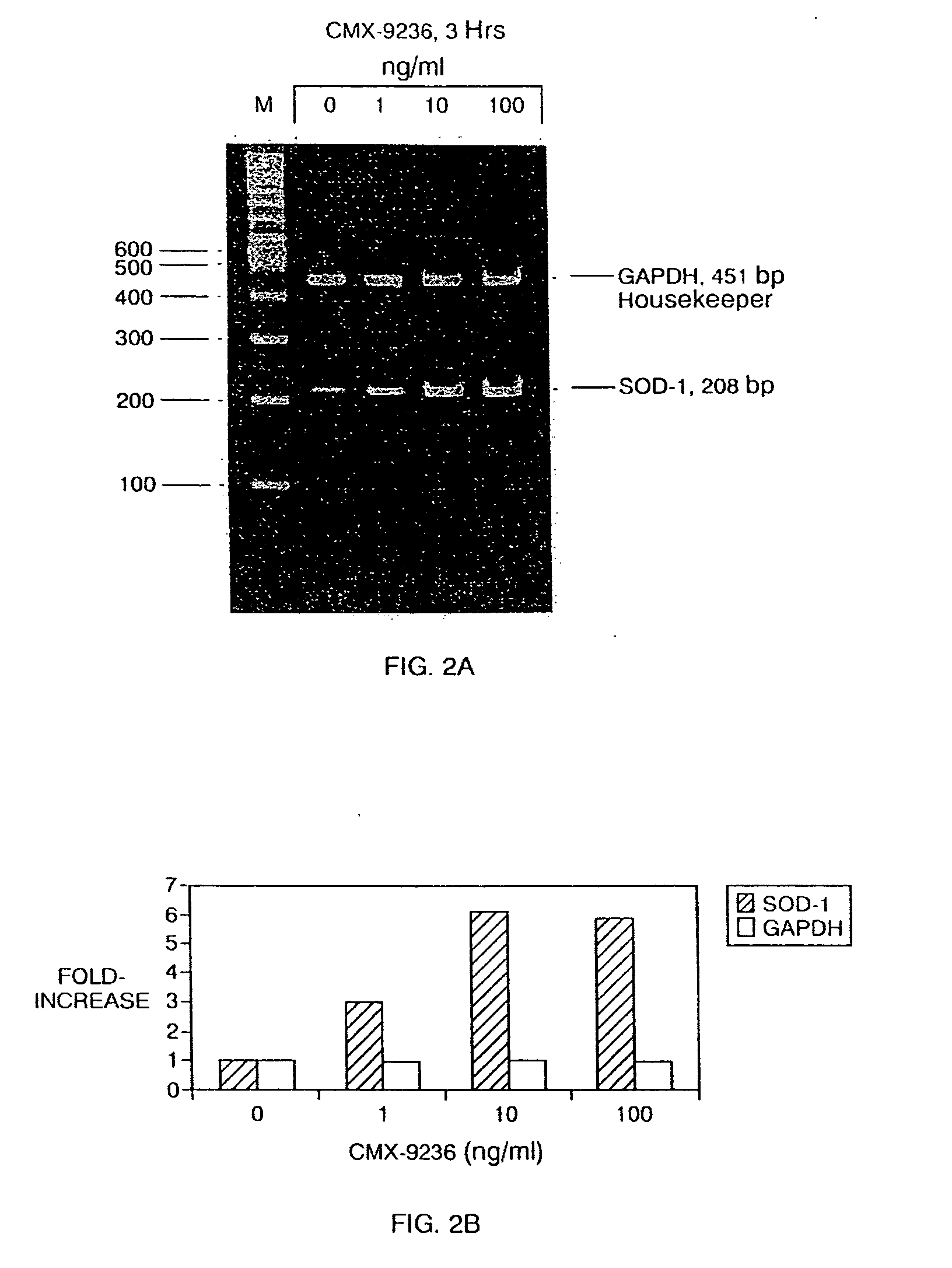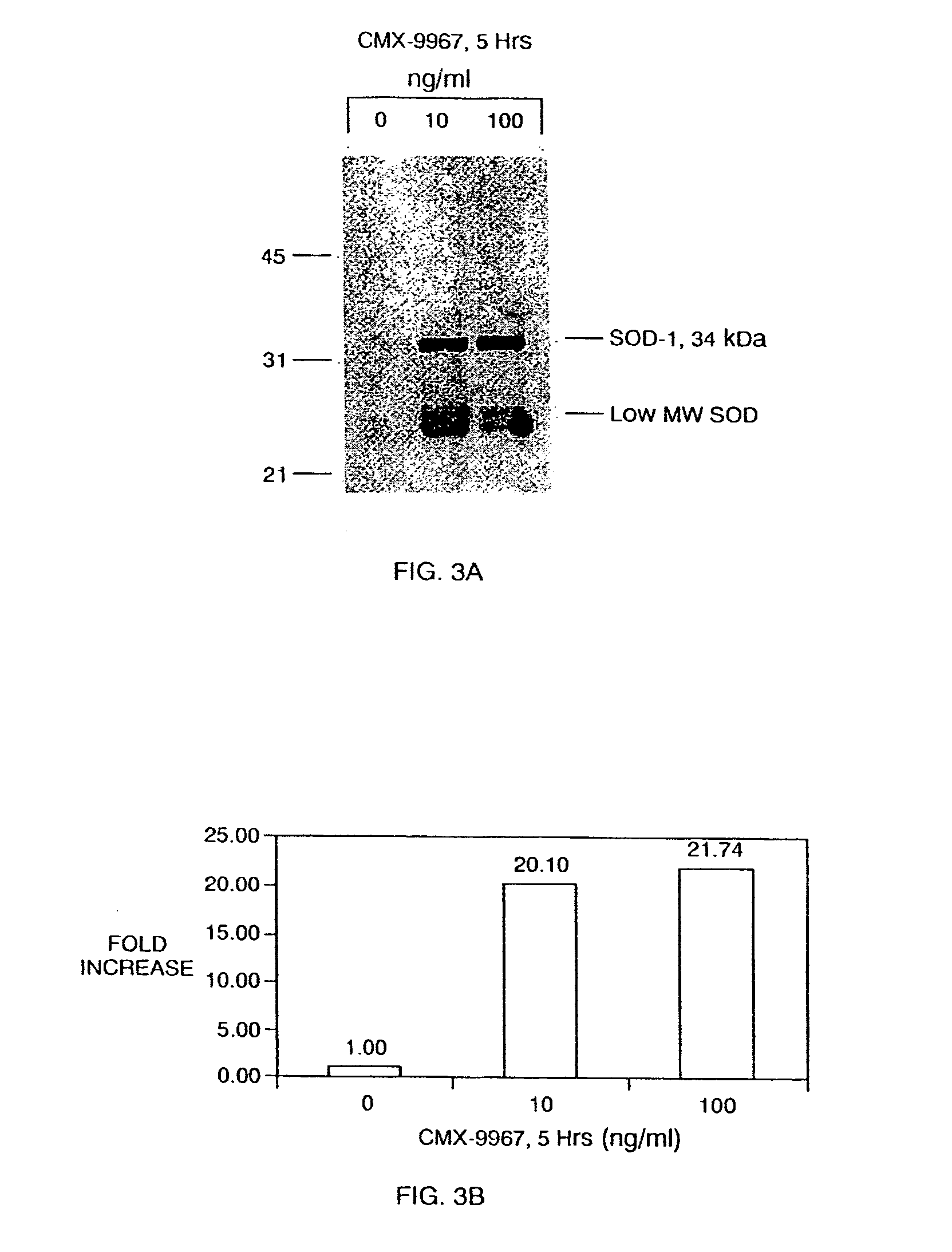Compositions and methods for counteracting effects of reactive oxygen species and free radicals
a technology of reactive oxygen species and free radicals, applied in the field of antioxidative compounds, can solve the problems of reducing the level of ros or free radicals in the cell, affecting the antioxidative activity of the cell, so as to reduce, eliminate or prevent an undesirable elevation of ros and free radicals, and restore the age-related reduction of constitutive antioxidative enzymes.
- Summary
- Abstract
- Description
- Claims
- Application Information
AI Technical Summary
Benefits of technology
Problems solved by technology
Method used
Image
Examples
example 1
Synthesis of Representative Peptide Compounds
[0138] The following representative peptide compounds were synthesized by solid phase Merrifield synthesis (Merrifield, J. Am. Chem. Soc., 85:2149-2154 (1963)):
CMX-9236D([DHA]-Lys Lys Asp Gly Asp Gly Asp(SEQ ID NO: 26)Phe Ala Ile Asp Ala Pro Glu),CMX-9236(Lys Lys Asp Gly Asp Gly Asp Phe(SEQ ID NO: 26)Ala Ile Asp Ala Pro Glu),CMX-11540([Lip]-Asp Gly Asp Gly Asp Phe Ala(SEQ ID NO: 16)Ile Asp Ala Pro Glu),CMX-99661([Gga] Asp Gly Asp Gly Phe Ala),(SEQ ID NO: 5)CMX-99655([Ac] Asp Gly Asp Gly Phe Ala),(SEQ ID NO: 5)CMX-9960([Palm] Asp Gly Asp Gly Phe Ala),(SEQ ID NO: 5)CMX-9963([Ac]-Asp Gly Asp Gly Asp Phe(SEQ ID NO: 6)Ala),CMX-9967([Ac]-Asp Gly Asp),CMX-9901(Lys Lys Gln Tyr Lys Leu Gly Ser(SEQ ID NO: 27)Lys Thr Gly Pro Gly Gln),CMX-8933(Lys Lys Glu Thr Leu Gln Phe Arg),(SEQ ID NO: 24)CMX-9902(Lys Lys Asp Gly Asp Gly Asp Phe(SEQ ID NO: 28)Ala),CMX-99658([Ac]-Gln Thr Leu Gln Phe Arg),(SEQ ID NO: 2)Lys Lys Gln Thr Leu Gln Phe Arg,(SEQ ID NO: 2...
example 2
Upregulation of Superoxide Dismutase (SOD) and Catalase (CAT) in Mammalian Cells By Peptide Compounds CMX-9236, CMX-9963, and CMX-9967
Upregulation of SOD
[0142] The RT-PCR method (see, for example, Innis et al., PCR Protocols: A Guide to Methods and Applications, (Academic Press, San Diego, 1990)) was used to investigate the upregulation of the specific mRNA that codes for the enzyme superoxide dismutase (SOD).
[0143] Primary cortical cultures were obtained by growing newborn rat brain cortical cells in Delbecco's modified Eagle medium supplemented with 25 μg / ml of gentamycin and 10% fetal calf serum. The cells were isolated from the E-21 cortex of rat brain, plated at a density of 1×105 per ml and grown to confluence within four to five days in an atmosphere containing air and 5% CO2 at 37° C. as described in Cornell-Bell et al., Science, 247: 470-473 (1990) and Cell Calcium, 12: 185-204 (1991). Cultures were grown in 20 ml flasks as a monolayer and then exposed to various concen...
example 3
Upregulation of AP-1 Transcription Factor in Mammalian Cells By Peptide Compounds
[0158] Immediately prior to use, a 1.0 mg aliquot of a peptide compound was dissolved in 1.0 ml of 5% xylitol in HBSS (Hanks' Balanced Salt Solution, Hanks and Wallace, Proc. Soc. Exp. Biol. Med. 71:196 (1949)), the pH neutralized with 0.1 N NaOH, and the solution filter sterilized. Each peptide compound migrated as a single peak on HPLC column (C-18). The structure of each peptide compound was confirmed by amino acid analysis, and its molecular weight was verified by mass spectroscopy.
[0159] Nuclear extracts for electrophoretic mobility shift assays (EMSAs) were prepared as described previously (Adams et al., J. Leukocyte Biol., 62: 865-873 (1997)) using 1.0-2.0×107 cells per sample. All buffers were freshly supplemented with dithiothreitol (DTT, 0.5 mM), protease inhibitors: PMSF (0.5 mM), chymostatin, peptstatin-A, aprotinin, antipain, leupeptin (each at 1 μg / ml), and phosphatase inhibitors: NaF (1...
PUM
| Property | Measurement | Unit |
|---|---|---|
| Composition | aaaaa | aaaaa |
| Acidity | aaaaa | aaaaa |
Abstract
Description
Claims
Application Information
 Login to View More
Login to View More - R&D
- Intellectual Property
- Life Sciences
- Materials
- Tech Scout
- Unparalleled Data Quality
- Higher Quality Content
- 60% Fewer Hallucinations
Browse by: Latest US Patents, China's latest patents, Technical Efficacy Thesaurus, Application Domain, Technology Topic, Popular Technical Reports.
© 2025 PatSnap. All rights reserved.Legal|Privacy policy|Modern Slavery Act Transparency Statement|Sitemap|About US| Contact US: help@patsnap.com



